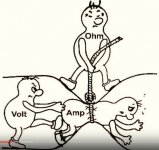theophilus88
Professional Architectural Engineer
- Location
- St. Louis, MO
- Occupation
- Professional Architectural Engineer
I don't know why this is bugging me so much, and I'm sure there's a simple analogy, but in terms of voltage drop, how does increasing a conductors size reduce the circuits resistance? Aren't we adding more resistance by increasing the size of the conductor? For Ohm's law, I've always used the analogy of water flow, pressure, and pipe size, but for voltage drop, this analogy doesn't seem to hold. Does anyone have a better explanation for how increasing a conductors size reduces voltage drop?



